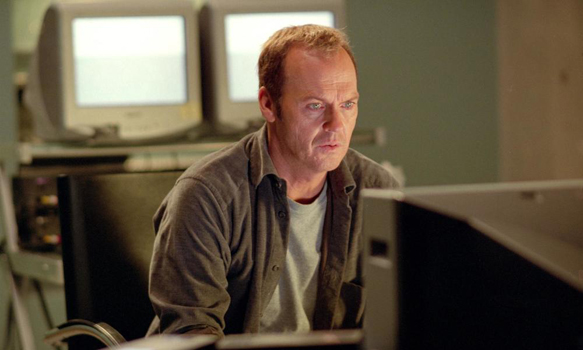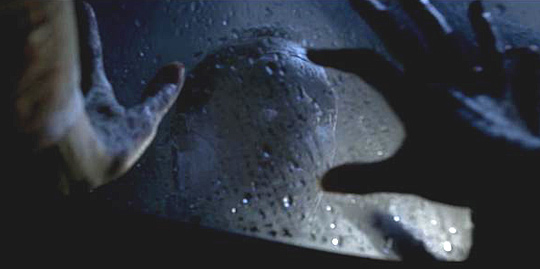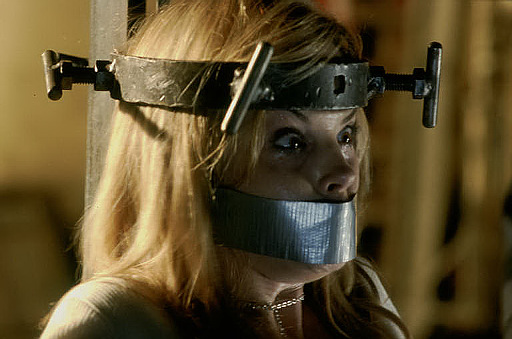“Listen to me. It is one thing to contact the dead, it is another thing to meddle, and you are meddling,” Mirabelle Keegan (Keegan Connor Tracy: Double Jeopardy 1999, Dead Rising: Watchtower 2015) accuses Jonathan Rivers (Michael Keaton: Batman 1989, Birdman: Or (The Unexpected Virtue of Ignorance) 2014) in the supernatural film, White Noise, which celebrated its tenth anniversary January 7th. White Noise was directed by Geoffrey Sax (Circle of Deceit 1993, Christopher and His Kind 2011) and produced by Paul Brooks (Beyond Bedlam 1993, Pitch Perfect 2 2015) from a script written by Niall Johnson (The Big Swap 1998, Keeping Mum 2005) for Gold Circle Films and Brightlight Pictures, with distribution by Universal Pictures.
- Still from White Noise
Jonathan Rivers and his wife, Anna (Chandra West: Puppet Master 4 1993, Hidden Moon 2012) have the perfect life with their son, Mike (Nicholas Elias: White Noise was his first role, The Shortcut 2009), and a baby on the way until Anna goes missing. Raymond Price (Ian McNeice: Voice Over 1983, Nativity 2: The Second Coming 2012) seeks Jonathan out to tell him he’s been contacted by Anna from beyond the grave using EVP (Electronic Voice Phenomenon)… and he can teach Jonathan how. Will Jonathan and Anna connect, or will Jonathan just open Pandora’s Box?
White Noise was based off writer Niall Johnson’s thought of reaching loved ones who have died. After doing research on EVP, he found that the technique had a big following. After luring director Geoffrey Sax, the team had to find their Jonathan. Michael Keaton was their first choice, who went into the role with the idea of making Jonathan your everyday guy, not overly dramatic, which he pulls off until the obsession of trying to keep that bond goes awry. Though Keaton’s portrayal’s believable and his grief is palpable, he admits to phoning in his part in the DVD commentary. West’s turn as Anna, in her timed, fleeting parts, serves as enabler and warning to Jonathan’s EVP addiction, which is really his wife while McNeice’s Raymond is the catalyst. As well meaning as he is, Raymond has set Jonathan’s path in motion, along with Deborah Kara Unger’s (Until There was You 1991, Samuel Bleak 2013) Sarah, who also has lost someone. They become partners in crime, while the aforementioned Mirabelle Keegan, a blind medium, serves as Jonathan’s physical guide. Across the board, these characters were believable, even when Jonathan slips, as people handle grief differently.
- Still from White Noise
Aside from the plot device of EVP, White Noise’s plot, as heartfelt as it was, could be considered cliché to the genre with the themes of wanting to reconnect by any means necessary, delving into the unknown unprepared and living or not living with the consequences. A similar plot was also shown in 2002’s Dragonfly, minus the EVP. On an interesting note, the film reportedly uses real EVP recordings of Stanley Searles (“I love you.”), a past politician who died in 2002, which was made by Searles’ daughter. The EVP recording of “I will see you no more.” is attributed to a woman named Ruth Baxter, who died in 1987, by EVP researcher named Sarah Estep.
Shot in British Columbia, Canada, the sets had a lived-in, organic and a high-tech soundstage for all the EVP detecting gadgets Jonathan acquires. Production designer, Michael S. Bolton (White Fang 1991, Fear the Walking Dead TV series 2015), and cinematographer, Chris Seager (Stonewall 1995, A Kind of Murder 2015), adjusted the tone, with the house being more pastel before Anna died and gradually muting and muddying colors. They also manipulated angles for effect because they did notwant the movie to be weighed down by excessive CG.
Ultimately, White Noise received negative reviews from critics, and has 8% rotten rating on Rotten Tomatoes; yet, making $91.1 mill on a $10 mill budget, capitalizing on the unpopular weekend after New Year’s. Seeing White Noise’s numbers, studios followed suit. Throughout the years, the film has been referenced in TV, film, and video. For example, 2005’s Hearing Is Believing: Actual EVP Sessions video documentary, which goes in-depth with the medium, while 2006’s Benchwarmers has a glimpse of the video case in a store. Then, 2009’s Family Guy episode, “Quagmire’s Cat,” when Chris mentions the film as well as being mentioned in 2010’s TV movie, Gonger 2 – Das Böse Kehrt Zurück. Inevitably, White Noise was spoofed in 2009’s The Recycled Movie, when inept guys create EVPs. Finally, White Noise 2: The Light was released in 2007, not to mention all the EVP-featured paranormal television shows currently making a run.
- Still from White Noise
Although White Noise had a love/hate relationship with box office success and critic negativity, the audience obviously relates and has given it cult status. The notion of “what if” has, and will, keep the legacy of White Noise fresh for generations to come.
- Universal Pictures









No comment